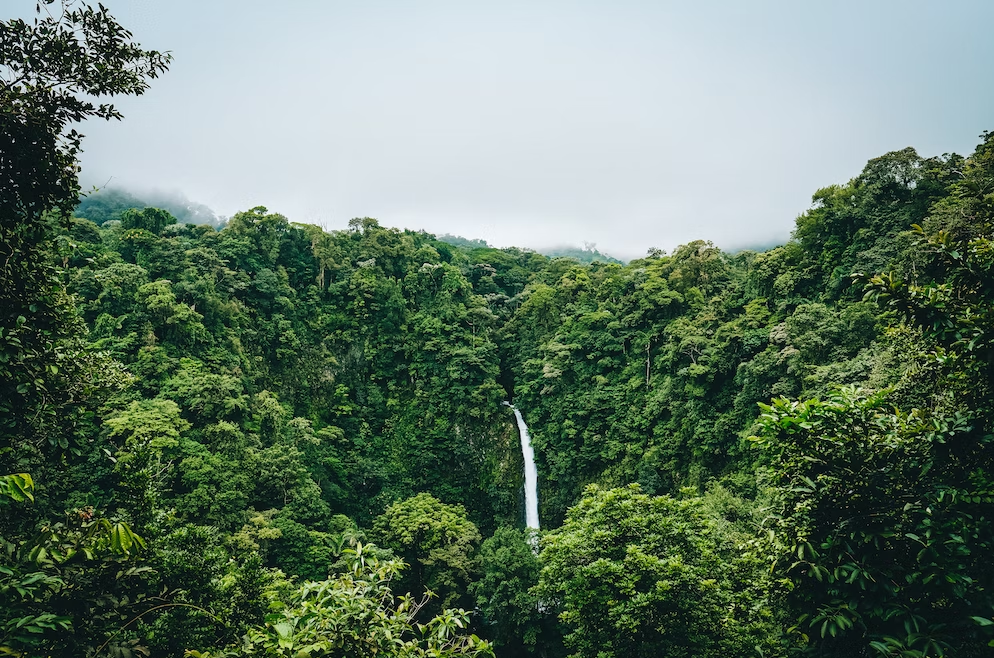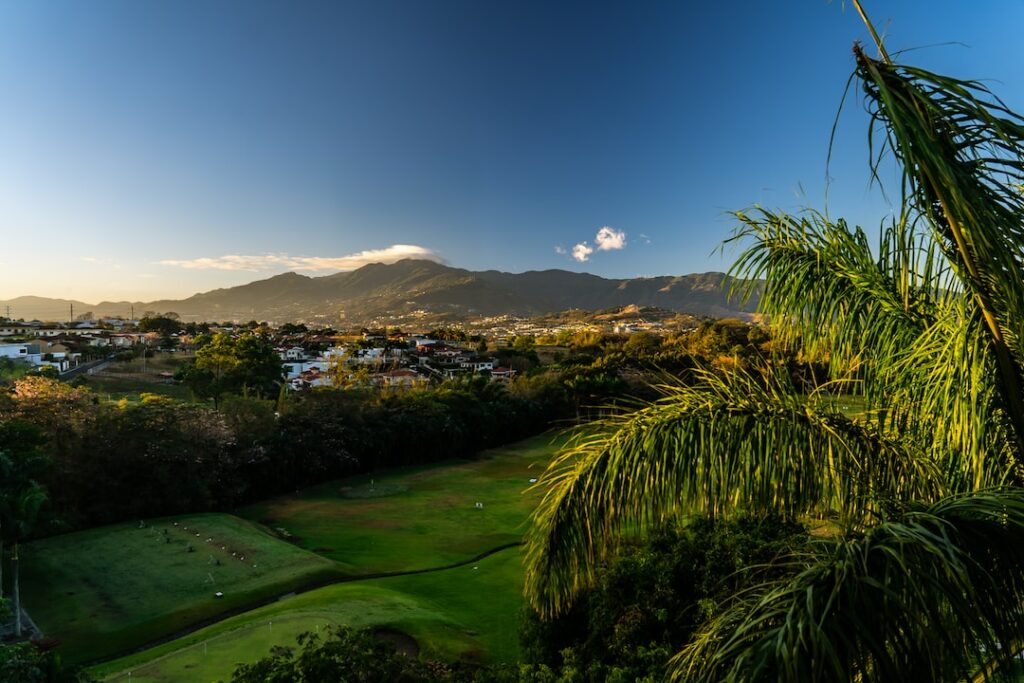Most of public buses in Nicaragua are the yellow School Buses, which are used to drive children to school in America. In Costa Rica and Nicaragua they are called chicken buses. They constitute a majority of public transport in those countries, although the seats are too small and the height of the bus is not designed for adults. 🙂 The oldest bus we saw was from 1964.
The locals say the buses operate without any breakdowns and even the oldest ones can still drive long distances without any problems. The buses in those two countries are ridiculously cheap, even when driving long distances between the cities. The back emergency door are used as main exit for passengers, parcels, luggage, and all other equipment.
The buses
The buses are usually extremely crowded, so it’s almost impossible to get to the front door, and it means you have to use the back – emergency door. People traveling on the back of the bus usually have lots of luggage, food, fruits, etc. So it’s easy to unload it by using back door.
The most terrifying thing is that usually the driver doesn’t even stop the vehicle, when the other guy is pulling your luggage out from the bus, through the opened emergency door. Sometimes the luggage guy even travels outside the bus, standing on a tiny step or a small ladder. Anyway, this is one and only experience you can get in Latin America. It is overall a great fun for travelers and bring lots of laugh!
Practical information on public transport in Nicaragua!
In general public transport in NIcaragua is well deveoped and you will be able to reach any destination – on the basis of short and long distance. It is very well organized in the cities. Transport between the cities is probably a little more challenging, some buses operate once a day but it is still doable.
Some bus stops are a tiny roofed construction and for some you would need to ask the locals. Tickets /in 2017/ all tickets were sold in the buses. It’s hassle free, as the person will find you and you will pay very small money for most of the buses. I am only talking about the cheapest public transport in Nicaragua.
Long distance public buses
We had to leave Corn Islands (located on the Caribbean Sea). We got up to catch a very early flight from Big Corn Island to Bluefields-sea port on the mainland. I usually use cheap local transport, but this is a separate thriller story why I flew this time, available to read here. 🙂
There is no land road between Bluefields (sea port) and El-Rama. You have to travel 90 km by fast boat (Panga) through the river (full of local inhabitants – crocodiles).
It takes maximum 2 hours to reach El-Rama from Bluefields. We were hoping to catch a bus from El Rama to Managua – the capital of Nicaragua. Of course the locals tricked us as usual, because by the time we hit the office the tickets were already sold out…
No tickets
Obviously they had some tickets kept for local residents, which is a common practice. Buying any kind of transportation ticket in this country (except touristic places). You’ll probably have to deal with long queues, filling receipts and your luggage search by armed soldiers.
Don’t worry you just need to get used to the picture of armed soldiers. Be patient while going through all these procedures. They all have very friendly atitude.
Usually, there’s only one bus a day to each destination, so it’s nice to get a ticket for it. Otherwise you can set up a peace a carton on the ground and wait for next transport, which happened few times to us.
While waiting in any queue in order to get a transport ticket, you can be sure that other locals will pass their ID’s to the one’s already in the queue, instead of going to the end of the queue. By the time you finally reach the ticket window you can be almost sure to hear ‘no buletos’! (no tickets!).
Chicken buses!
Nicaragua, year 2017. The story is written in a humorous way – Nicaraguan people are great, friendly and I have a lot of respect for them. When I heard from the driver that there are no tickets for the bus I got really annoyed.
Firmly stated that we’re going by this bus even if we have to stand for 6 hours. Suddenly it turned out that we do have seats – on the restored buckets placed upside down in the narrow passage of the bus. 🙂
Small projections on the bottom of the lid were a little irritating but I covered them with my jacket and suddenly it became quite comfortable. The most important thing is that we are in the bus!
In every bus there is always a driver’s buddy sitting on the front of the vehicle, he’s usually collecting ticket money and whistles when someone needs to get of. When the bus makes a stop you can hear door mechanism hissing sound, the buddy immediately pushes the door outside, of course while the bus is still moving.
All windows are opened in the bus and the wind blows straight into passengers’ faces and keeps tousle everyone’s hair. Although everyone is shutting the eyes nobody makes an effort to close the windows to avoid the draft.
Interesting route
At least it’s warm, so you won’t catch a cold. We slowly drive the narrow asphalt road. Sometimes I stand up to stretch and straighten my bones. Bumping is a fundamental driver’s activity. Every occasion is good for bumping, bus driving the other way, car turning, cows crossing the road.
There are number of cords next to the driver for different types of horn, used for particular road situation: greeting, warning, welcoming, etc. Each occasion has a different horn! In the middle of the ride we stop to have a half-hour lunch break. Most of the Nicaraguans are plump.
It’s really rare to find a slim person. 30 km before reaching the destination it’s hard to believe we stop again. Few curly people get inside the bus with huge bowls of food. What does it mean – trade! Street trade is a second face of this country. Most of the food packed in small plastic bags.
Interesting route
They place the bowl on their head or under their’s arm. I’m already nervous as the bus is full. This means those curly women will have to pass through this little passage where I’m sitting. If this grown woman mistakenly steps on my pail, it will definitely going crash into thousand pieces!
After having a big lunch an hour ago I’m sure nobody would be interested in buying more food. Wrong! And here we go again with buns, pastries, fried chicken, all squized in small plastic bags, banana chips, stuffed potatoes.
Now the beverages take the second round. 🙂 We are trapped in the middle of this terrible mess in a tiny passage. Finally, we continue the ride. We just need to drive through a busy capital – Managua to catch another chicken bus. 🙂
Public transport in Nicaragua
Most of public buses in Nicaragua are the yellow American School buses, which are used to drive children to school. In Costa Rica and Nicaragua they are called chicken buses.
They constitute a majority of public transport in those countries, although the seats are too small and the height of the bus is not designed for adults. 🙂
The oldest bus we saw was from 1964. The locals say the buses operate without any breakdowns and even the oldest ones can still drive long distances without any problems. The buses in those two countries are ridiculously cheap, even when driving long distances between the cities.
What else you should know?
The back emergency door are used as main exit for passengers, parcels, luggage, and all other equipment. The buses are usually extremely crowded, so it’s almost impossible to get to the front door, and it means you have to use the back – emergency door.
People traveling on the back of the bus usually have lots of luggage, food, fruits, etc. So it’s easy to unload it by using back door.
The most terrifying thing is that usually the driver doesn’t even stop the vehicle, when the other guy is pulling your luggage out from the bus, through the opened emergency door.
Sometimes the luggage guy even travels outside the bus, standing on a tiny step or a small ladder. Anyway, this is one and only experience you can get in Latin America. It is overall a great fun for travelers and bring lots of laugh!





